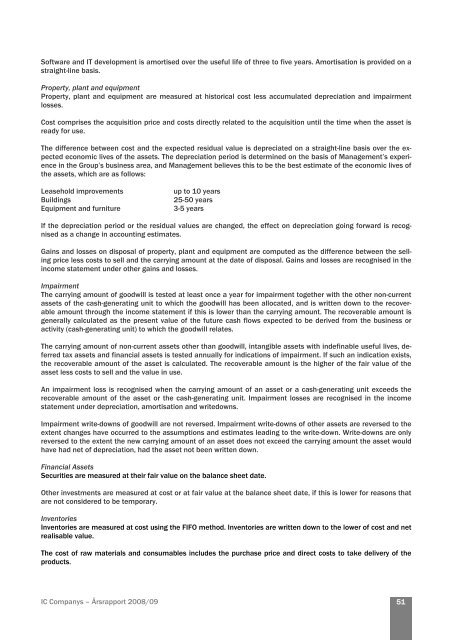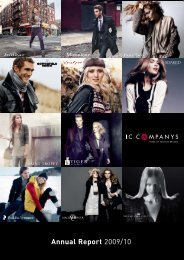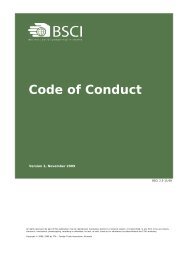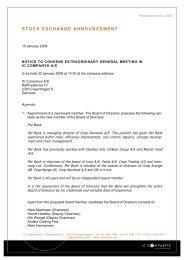IC Companys â Annual Report 2008/09 0 - IC Companys A/S
IC Companys â Annual Report 2008/09 0 - IC Companys A/S
IC Companys â Annual Report 2008/09 0 - IC Companys A/S
Create successful ePaper yourself
Turn your PDF publications into a flip-book with our unique Google optimized e-Paper software.
Software and IT development is amortised over the useful life of three to five years. Amortisation is provided on a<br />
straight-line basis.<br />
Property, plant and equipment<br />
Property, plant and equipment are measured at historical cost less accumulated depreciation and impairment<br />
losses.<br />
Cost comprises the acquisition price and costs directly related to the acquisition until the time when the asset is<br />
ready for use.<br />
The difference between cost and the expected residual value is depreciated on a straight-line basis over the expected<br />
economic lives of the assets. The depreciation period is determined on the basis of Management’s experience<br />
in the Group’s business area, and Management believes this to be the best estimate of the economic lives of<br />
the assets, which are as follows:<br />
Leasehold improvements up to 10 years<br />
Buildings 25-50 years<br />
Equipment and furniture 3-5 years<br />
If the depreciation period or the residual values are changed, the effect on depreciation going forward is recognised<br />
as a change in accounting estimates.<br />
Gains and losses on disposal of property, plant and equipment are computed as the difference between the selling<br />
price less costs to sell and the carrying amount at the date of disposal. Gains and losses are recognised in the<br />
income statement under other gains and losses.<br />
Impairment<br />
The carrying amount of goodwill is tested at least once a year for impairment together with the other non-current<br />
assets of the cash-generating unit to which the goodwill has been allocated, and is written down to the recoverable<br />
amount through the income statement if this is lower than the carrying amount. The recoverable amount is<br />
generally calculated as the present value of the future cash flows expected to be derived from the business or<br />
activity (cash-generating unit) to which the goodwill relates.<br />
The carrying amount of non-current assets other than goodwill, intangible assets with indefinable useful lives, deferred<br />
tax assets and financial assets is tested annually for indications of impairment. If such an indication exists,<br />
the recoverable amount of the asset is calculated. The recoverable amount is the higher of the fair value of the<br />
asset less costs to sell and the value in use.<br />
An impairment loss is recognised when the carrying amount of an asset or a cash-generating unit exceeds the<br />
recoverable amount of the asset or the cash-generating unit. Impairment losses are recognised in the income<br />
statement under depreciation, amortisation and writedowns.<br />
Impairment write-downs of goodwill are not reversed. Impairment write-downs of other assets are reversed to the<br />
extent changes have occurred to the assumptions and estimates leading to the write-down. Write-downs are only<br />
reversed to the extent the new carrying amount of an asset does not exceed the carrying amount the asset would<br />
have had net of depreciation, had the asset not been written down.<br />
Financial Assets<br />
Securities are measured at their fair value on the balance sheet date.<br />
Other investments are measured at cost or at fair value at the balance sheet date, if this is lower for reasons that<br />
are not considered to be temporary.<br />
Inventories<br />
Inventories are measured at cost using the FIFO method. Inventories are written down to the lower of cost and net<br />
realisable value.<br />
The cost of raw materials and consumables includes the purchase price and direct costs to take delivery of the<br />
products.<br />
<strong>IC</strong> <strong>Companys</strong> – Årsrapport <strong>2008</strong>/<strong>09</strong><br />
51


